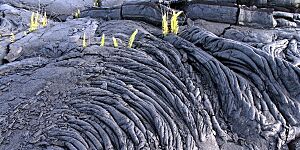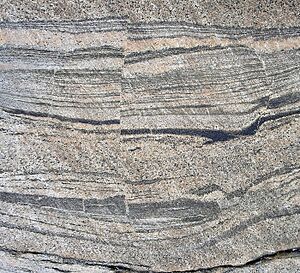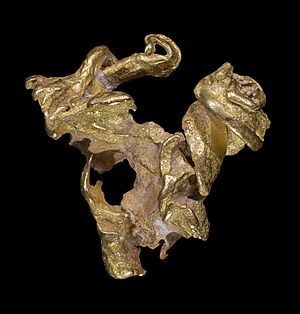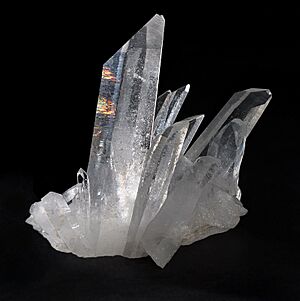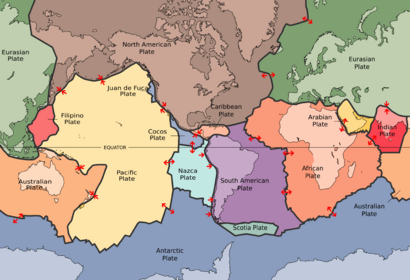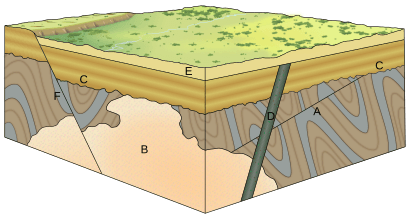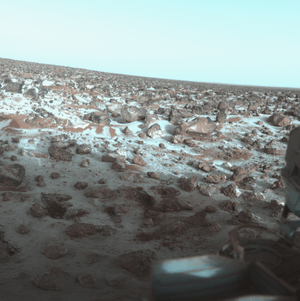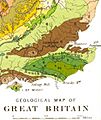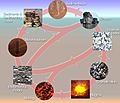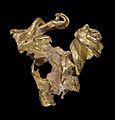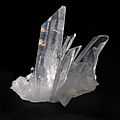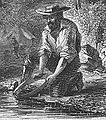Geology facts for kids
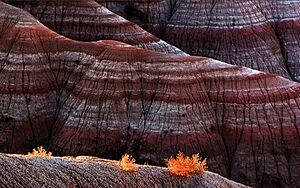
Geology is the exciting science that studies the Earth and other planets. It's all about the rocks they are made of and the amazing processes that change them over time. The word "geology" comes from the Greek words gê (meaning "earth") and logos (meaning "study of").
Geology helps us understand everything from giant mountains to tiny crystals. Scientists who study geology are called geologists. They investigate the history of our planet, which is billions of years old. They also study how the Earth is changing today.
Geology is very important for our daily lives. It helps us find important resources like water, metals, and energy. It also helps us understand and prepare for natural events like earthquakes and volcanic eruptions. By studying geology, we can learn about past climates and better understand climate change today.
Contents
What the Earth is Made Of
Geologists study the materials that make up our planet. These materials can be solid rocks, minerals, or even molten rock deep underground.
Minerals: The Building Blocks of Rocks
Minerals are natural, solid materials found on Earth. Think of them as the building blocks of rocks. Every mineral has a specific chemical recipe and its atoms are arranged in a neat, repeating pattern, like a crystal.
Geologists identify minerals by testing their physical properties. Some of these tests include:
- Color: What color is the mineral? Sometimes, small impurities can change a mineral's color.
- Streak: What color powder does it leave when scratched on a special porcelain plate?
- Hardness: How easily can the mineral be scratched? The Mohs scale ranks minerals from 1 (softest, like talc) to 10 (hardest, like diamond).
- Breakage: Does it break along smooth, flat surfaces (called cleavage) or in a rough, uneven way (called fracture)?
- Luster: How does it reflect light? It could be shiny like metal, glassy, pearly, or dull.
Rocks: Three Main Types
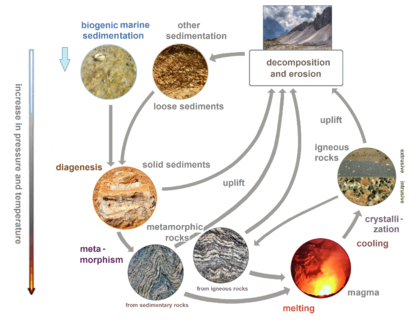
A rock is a solid material made up of one or more minerals. Geologists group rocks into three main types based on how they are formed. The rock cycle shows how these types are connected.
Igneous Rocks
Igneous rocks are formed when hot, molten rock called magma (underground) or lava (on the surface) cools and becomes solid. When lava from a volcano cools quickly, it forms rocks with tiny crystals, like basalt. When magma cools slowly deep underground, it forms rocks with large crystals, like granite.
Sedimentary Rocks
Sedimentary rocks are made from pieces of other rocks, minerals, or organic matter. Over millions of years, wind and water break down rocks into small pieces called sediment. This sediment is carried away and settles in layers. The weight of the layers on top squeezes the lower layers together, and minerals act like glue to cement the pieces into a solid rock. Sandstone, shale, and limestone are common sedimentary rocks. Fossils are often found in these rocks.
Metamorphic Rocks
Metamorphic rocks are rocks that have been changed by intense heat and pressure deep inside the Earth. The heat and pressure can change the minerals and texture of the rock without melting it. For example, limestone can be transformed into marble, and shale can become slate.
The Earth's Moving Surface
Plate Tectonics
The Earth's surface isn't one solid piece. It's broken up into huge, slow-moving puzzle pieces called tectonic plates. This idea is called the theory of plate tectonics. These plates float on a hotter, softer layer of rock in the mantle.
The movement of these plates shapes our planet. Where plates interact, we see amazing geological features:
- Divergent Boundaries: Where two plates move apart. Magma rises from the mantle to create new crust, often forming underwater mountain ranges called mid-ocean ridges.
- Convergent Boundaries: Where two plates collide. One plate might slide under the other (a process called subduction), which can create deep ocean trenches, volcanoes, and mountain ranges like the Andes.
- Transform Boundaries: Where two plates slide horizontally past each other. This movement can cause powerful earthquakes, like those along the San Andreas Fault in California.
Inside the Earth
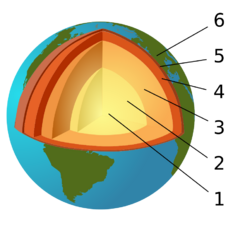
Scientists have learned about the Earth's interior by studying the waves from earthquakes. Our planet is made of several layers, like an onion:
- Crust: A thin, rocky outer layer. It's the part we live on.
- Mantle: A thick layer of hot, solid rock beneath the crust. It flows very slowly, like thick honey, which causes the tectonic plates to move.
- Outer Core: A layer of liquid iron and nickel. The movement of this liquid metal creates the Earth's magnetic field.
- Inner Core: A solid ball of iron and nickel at the very center of the Earth. It's incredibly hot, but the immense pressure keeps it solid.
Geological Time
The Earth is incredibly old—about 4.54 billion years! Geologists have created a timeline called the geological time scale to organize this vast history. It's divided into large chunks of time called eons, eras, periods, and epochs.

Key Moments in Earth's History
- 4.54 billion years ago: The Earth is formed.
- c. 4 billion years ago: The first life appears.
- c. 2.3 billion years ago: The atmosphere begins to fill with oxygen, thanks to tiny photosynthetic organisms.
- 541 million years ago: The Cambrian explosion, a time when many different kinds of animals first appeared in the oceans.
- 250 million years ago: The largest mass extinction in Earth's history marks the end of the Paleozoic Era.
- 66 million years ago: The dinosaurs go extinct, marking the end of the Mesozoic Era and the beginning of the Cenozoic Era (the "Age of Mammals").
- c. 200 thousand years ago: The first modern humans (Homo sapiens) appear.
How We Date Rocks
Geologists have two main ways to figure out the age of rocks and fossils.
Relative Dating
Relative dating doesn't give an exact age in years. Instead, it tells us if one rock is older or younger than another. Geologists use several simple rules:
- Law of Superposition: In a stack of undisturbed sedimentary rock layers, the bottom layers are the oldest and the top layers are the youngest.
- Principle of Cross-Cutting Relationships: If a rock feature like a fault or an igneous intrusion cuts through other rocks, it must be younger than the rocks it cuts.
- Principle of Faunal Succession: Fossils appear in a specific order in rock layers. We can use the types of fossils in a rock to determine its relative age.
Absolute Dating
Absolute dating gives a more precise age in years. The most common method is radiometric dating. Some elements in rocks are radioactive, meaning they break down, or decay, at a steady, predictable rate. By measuring the amount of the original element and the amount of the decayed element, scientists can calculate how long it has been since the rock formed. It's like a natural clock inside the rock.
What Geologists Do
Geologists work in many different fields, from exploring for resources to protecting the environment.
Field Work
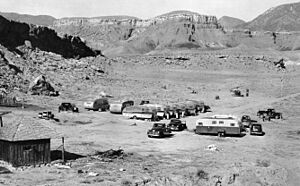
A lot of geology happens outdoors. Geologists go on field trips to study rocks, map landforms, and collect samples. They use tools like hammers, compasses, and GPS devices to record their observations. This helps them create geological maps, which show the types and ages of rocks in an area.
Laboratory Work
Back in the lab, geologists analyze the samples they collected. They might use powerful microscopes to look at the minerals in a rock or use chemical tests to determine its composition. This detailed work helps them piece together the story of how the rock formed and what has happened to it since.
Geology on Other Planets
Geology isn't just about Earth! The field of planetary geology uses the same principles to study other planets, moons, and asteroids in our solar system. By studying the giant volcanoes on Mars, the icy surface of Jupiter's moon Europa, or the craters on our own Moon, scientists can learn more about how planets form and change over time.
Why Geology Matters
Geology plays a huge role in our world.
- Economic Geology: Geologists help find and manage natural resources like metals (iron, copper), minerals (salt, quartz), and energy sources (oil, natural gas, coal).
- Engineering Geology: Before building a bridge, a dam, or a skyscraper, engineers need to know about the ground underneath. Geologists study the strength and stability of rocks and soil to make sure structures are safe.
- Environmental Geology: Geologists help solve environmental problems. They study how to clean up pollution, find safe places to store waste, and manage our water resources.
- Natural Hazards: Geologists study earthquakes, volcanoes, landslides, and tsunamis. Their work helps us understand these dangers, predict when they might happen, and build communities that are safer.
History of Geology
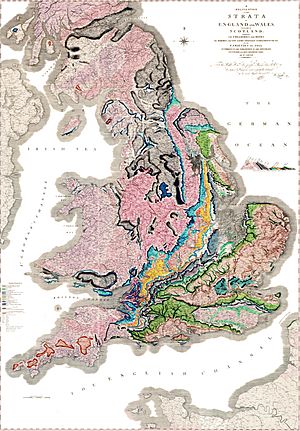
People have studied rocks and minerals for thousands of years. But modern geology began to take shape in the 18th and 19th centuries.
- James Hutton (1726–1797) is often called the "Father of Modern Geology." He realized that the Earth was much older than people thought and that the slow processes we see today, like erosion, have been shaping our planet for a very long time. This idea is called uniformitarianism.
- William Smith (1769–1839) was an English surveyor who realized that layers of rock could be identified by the fossils they contained. He created the first geological map of a whole country.
- Alfred Wegener (1880-1930) proposed the theory of continental drift, suggesting that the continents were once joined together and have since moved apart. His ideas were not fully accepted until the 1960s, when the theory of plate tectonics provided the explanation for how the continents could move.
The development of plate tectonics was a revolution in geology, explaining many of the Earth's biggest features, from mountain ranges to earthquakes. Today, geology continues to be a dynamic science, helping us understand our planet's past and protect its future.
Gallery
-
Layers of sedimentary rock.
-
A fault cutting through older sedimentary rocks.
-
A conglomerate: sedimentary rock made from white pieces of older rock, mixed with red sand.
-
The geologist, David Johnston, on the side of Mount St. Helens.
-
Geologists look at rock samples to find minerals for mining.
-
This diagram shows the chemical movement at a deep sea vent on the ocean floor.
-
The rock cycle shows how igneous, sedimentary, and metamorphic rocks are related.
-
These rock layers in Utah show how older layers are at the bottom and younger ones are at the top.
-
The famous San Andreas Fault in California.
-
A geological map of Kittatinny Mountain. It shows how rocks were folded and faulted when the mountain formed.
-
A typical USGS field mapping camp in the 1950s.
-
A petrified log (wood turned to stone) in Petrified Forest National Park, Arizona, U.S.A.
-
Folded rock layers.
-
A man panning for gold on the Mokelumne River.
-
William Smith's geological map of England, Wales, and southern Scotland from 1815.
-
Mikhail Lomonosov, a Russian scientist who wrote an early book on geology.
-
James Hutton, a Scottish geologist often called the "father of modern geology".
-
John Tuzo Wilson, a Canadian scientist who helped develop the idea of plate tectonics.
-
The volcanologist David A. Johnston shortly before the 1980 eruption of Mount St. Helens.
Related pages
- Geography is the study of the Earth and its features, its people, and its natural events.
- Zoology is the study of animals.
- Botany is the study of plants and fungi.
See also
 In Spanish: Geología para niños
In Spanish: Geología para niños


